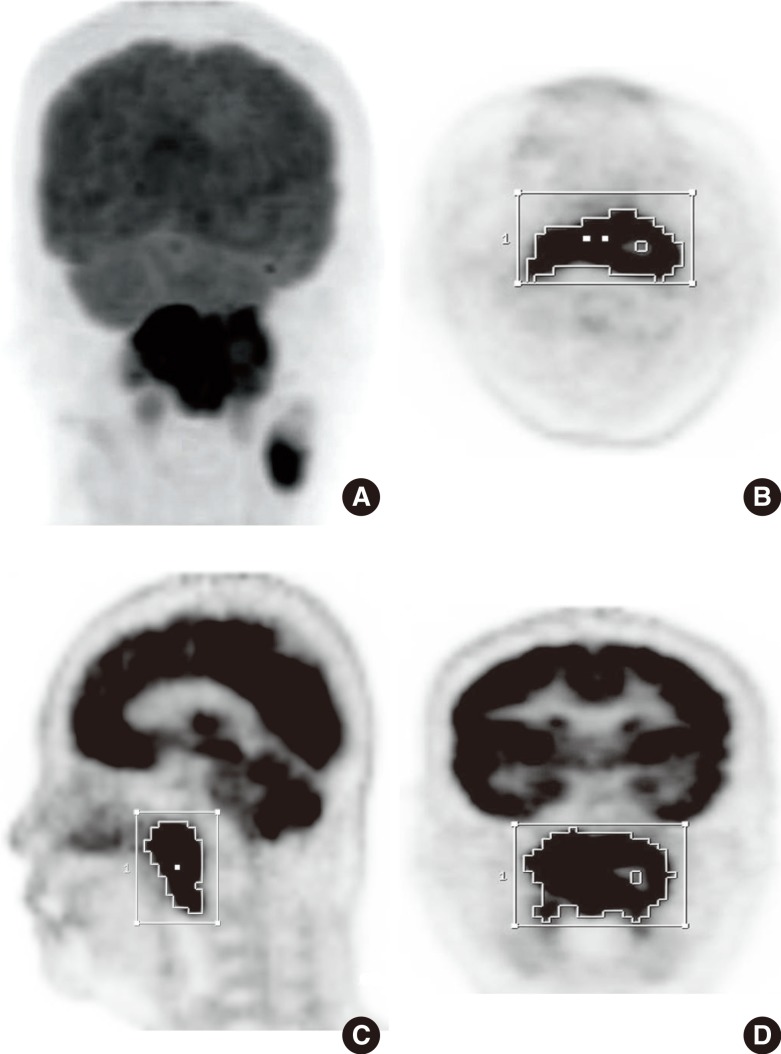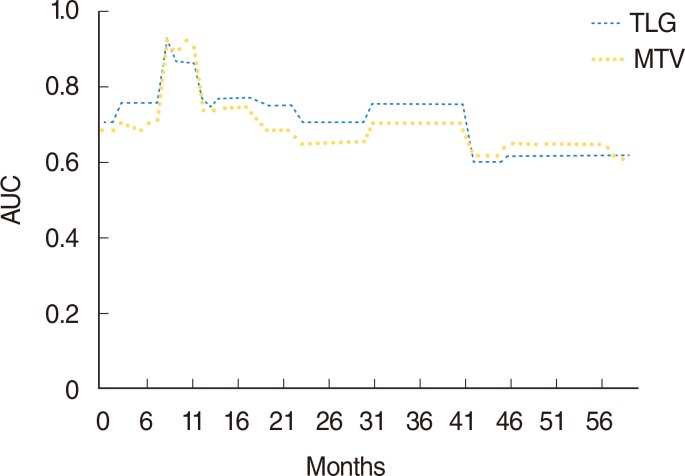Clin Exp Otorhinolaryngol.
2015 Jun;8(2):142-148. 10.3342/ceo.2015.8.2.142.
Prognostic Value of Volume-Based Positron Emission Tomography/Computed Tomography in Patients With Nasopharyngeal Carcinoma Treated With Concurrent Chemoradiotherapy
- Affiliations
-
- 1Department of Nuclear Medicine, Samsung Medical Center, Sungkyunkwan University School of Medicine, Seoul, Korea. jynm.choi@samsung.com
- 2Department of Otorhinolaryngology-Head and Neck Surgery, Samsung Medical Center, Sungkyunkwan University School of Medicine, Seoul, Korea.
- 3Department of Radiation Oncology, Samsung Medical Center, Sungkyunkwan University School of Medicine, Seoul, Korea.
- 4Division of Hematology-Oncology, Department of Medicine, Samsung Medical Center, Sungkyunkwan University School of Medicine, Seoul, Korea.
- KMID: 2360785
- DOI: http://doi.org/10.3342/ceo.2015.8.2.142
Abstract
OBJECTIVES
The aim of this study was to evaluate the prognostic value of volume-based metabolic parameters measured by 18F-fluorodeoxyglucose positron emission tomography (18F-FDG PET) in patients with nasopharyngeal carcinoma (NPC).
METHODS
Forty-four NPC patients who underwent 18F-FDG PET/CT for initial staging work-up before concurrent chemoradiotherapy (CCRT) were retrospectively evaluated. Maximum standardized uptake value (SUV), mean SUV, metabolic tumor volume (MTV), and total lesion glycolysis (TLG) of the primary tumors were measured. The prognostic significance and predictive performance of these parameters were assessed by Cox proportional hazards regression analysis and time-dependent receiver operating characteristics (ROC) curve analysis.
RESULTS
Multivariate analysis showed that American Joint Committee on Cancer stage 7th edition (hazard ratio [HR], 1.525; 95% confidence interval [CI], 1.062 to 2.188; P=0.022), and TLG (HR, 7.799; 95% CI, 2.622 to 23.198; P< or =0.001) were independent predictive factors associated with decreased disease-free survival (DFS). Time-dependent ROC curve analysis indicated that TLG was a better predictor of DFS than MTV (P=0.008).
CONCLUSION
The TLG of the primary tumor was a significant independent metabolic prognostic factor of DFS in patients with NPC treated with CCRT.
Keyword
MeSH Terms
Figure
Reference
-
1. Al-Sarraf M, Reddy MS. Nasopharyngeal carcinoma. Curr Treat Options Oncol. 2002; 2. 3(1):21–32. PMID: 12057084.2. Kim YS, Kim BS, Jung SL, Lee YS, Kim MS, Sun DI, et al. Radiation therapy combined with (or without) cisplatin-based chemotherapy for patients with nasopharyngeal cancer: 15-year experience of a single institution in Korea. Cancer Res Treat. 2008; 12. 40(4):155–163. PMID: 19688124.3. Zhang L, Zhao C, Ghimire B, Hong MH, Liu Q, Zhang Y, et al. The role of concurrent chemoradiotherapy in the treatment of locoregionally advanced nasopharyngeal carcinoma among endemic population: a meta-analysis of the phase III randomized trials. BMC Cancer. 2010; 10. 10:558. PMID: 20950416.
Article4. Lu H, Peng L, Yuan X, Hao Y, Lu Z, Chen J, et al. Concurrent chemoradiotherapy in locally advanced nasopharyngeal carcinoma: a treatment paradigm also applicable to patients in Southeast Asia. Cancer Treat Rev. 2009; 6. 35(4):345–353. PMID: 19211192.
Article5. Liu MT, Hsieh CY, Chang TH, Lin JP, Huang CC, Wang AY. Prognostic factors affecting the outcome of nasopharyngeal carcinoma. Jpn J Clin Oncol. 2003; 10. 33(10):501–508. PMID: 14623917.
Article6. Farias TP, Dias FL, Lima RA, Kligerman J, de Sa GM, Barbosa MM, et al. Prognostic factors and outcome for nasopharyngeal carcinoma. Arch Otolaryngol Head Neck Surg. 2003; 7. 129(7):794–799. PMID: 12874084.
Article7. Lee AW, Law SC, Foo W, Poon YF, Cheung FK, Chan DK, et al. Retrospective analysis of patients with nasopharyngeal carcinoma treated during 1976-1985: survival after local recurrence. Int J Radiat Oncol Biol Phys. 1993; 8. 26(5):773–782. PMID: 8344845.
Article8. Sham JS, Choy D. Prognostic value of paranasopharyngeal extension of nasopharyngeal carcinoma on local control and short-term survival. Head Neck. 1991; Jul-Aug. 13(4):298–310. PMID: 1869431.
Article9. Liu WS, Wu MF, Tseng HC, Liu JT, Weng JH, Li YC, et al. The role of pretreatment FDG-PET in nasopharyngeal carcinoma treated with intensity-modulated radiotherapy. Int J Radiat Oncol Biol Phys. 2012; 2. 82(2):561–566. PMID: 21300483.
Article10. Chan SC, Chang JT, Wang HM, Lin CY, Ng SH, Fan KH, et al. Prediction for distant failure in patients with stage M0 nasopharyngeal carcinoma: the role of standardized uptake value. Oral Oncol. 2009; 1. 45(1):52–58. PMID: 18487079.
Article11. Fletcher JW, Djulbegovic B, Soares HP, Siegel BA, Lowe VJ, Lyman GH, et al. Recommendations on the use of 18F-FDG PET in oncology. J Nucl Med. 2008; 3. 49(3):480–508. PMID: 18287273.
Article12. Schwartz DL, Rajendran J, Yueh B, Coltrera MD, Leblanc M, Eary J, et al. FDG-PET prediction of head and neck squamous cell cancer outcomes. Arch Otolaryngol Head Neck Surg. 2004; 12. 130(12):1361–1367. PMID: 15611393.
Article13. Higgins KA, Hoang JK, Roach MC, Chino J, Yoo DS, Turkington TG, et al. Analysis of pretreatment FDG-PET SUV parameters in head-and-neck cancer: tumor SUVmean has superior prognostic value. Int J Radiat Oncol Biol Phys. 2012; 2. 82(2):548–553. PMID: 21277108.
Article14. Allal AS, Slosman DO, Kebdani T, Allaoua M, Lehmann W, Dulguerov P. Prediction of outcome in head-and-neck cancer patients using the standardized uptake value of 2-[18F]fluoro-2-deoxy-D-glucose. Int J Radiat Oncol Biol Phys. 2004; 8. 59(5):1295–1300. PMID: 15275712.
Article15. Lee P, Weerasuriya DK, Lavori PW, Quon A, Hara W, Maxim PG, et al. Metabolic tumor burden predicts for disease progression and death in lung cancer. Int J Radiat Oncol Biol Phys. 2007; 10. 69(2):328–333. PMID: 17869659.
Article16. Choi KH, Yoo IeR, Han EJ, Kim YS, Kim GW, Na SJ, et al. Prognostic value of metabolic tumor volume measured by (18)F-FDG PET/CT in locally advanced head and neck squamous cell carcinomas treated by surgery. Nucl Med Mol Imaging. 2011; 3. 45(1):43–51. PMID: 24899977.
Article17. Hyun SH, Choi JY, Shim YM, Kim K, Lee SJ, Cho YS, et al. Prognostic value of metabolic tumor volume measured by 18F-fluorodeoxyglucose positron emission tomography in patients with esophageal carcinoma. Ann Surg Oncol. 2010; 1. 17(1):115–122. PMID: 19826877.
Article18. Moon SH, Choi JY, Lee HJ, Son YI, Baek CH, Ahn YC, et al. Prognostic value of 18F-FDG PET/CT in patients with squamous cell carcinoma of the tonsil: comparisons of volume-based metabolic parameters. Head Neck. 2013; 1. 35(1):15–22. PMID: 22307893.19. Kim BS, Kim IJ, Kim SJ, Nam HY, Pak KJ, Kim K, et al. The prognostic value of the metabolic tumor volume in FIGO stage IA to IIB cervical cancer for tumor recurrence: measured by F-18 FDG PET/CT. Nucl Med Mol Imaging. 2011; 3. 45(1):36–42. PMID: 24899976.
Article20. Lee HY, Hyun SH, Lee KS, Kim BT, Kim J, Shim YM, et al. Volume-based parameter of 18)F-FDG PET/CT in malignant pleural mesothelioma: prediction of therapeutic response and prognostic implications. Ann Surg Oncol. 2010; 10. 17(10):2787–2794. PMID: 20461469.21. La TH, Filion EJ, Turnbull BB, Chu JN, Lee P, Nguyen K, et al. Metabolic tumor volume predicts for recurrence and death in head-and-neck cancer. Int J Radiat Oncol Biol Phys. 2009; 8. 74(5):1335–1341. PMID: 19289263.
Article22. Chan SC, Chang JT, Lin CY, Ng SH, Wang HM, Liao CT, et al. Clinical utility of 18F-FDG PET parameters in patients with advanced nasopharyngeal carcinoma: predictive role for different survival endpoints and impact on prognostic stratification. Nucl Med Commun. 2011; 11. 32(11):989–996. PMID: 21862944.23. Juweid ME, Stroobants S, Hoekstra OS, Mottaghy FM, Dietlein M, Guermazi A, et al. Use of positron emission tomography for response assessment of lymphoma: consensus of the Imaging Subcommittee of International Harmonization Project in Lymphoma. J Clin Oncol. 2007; 2. 25(5):571–578. PMID: 17242397.
Article24. Zheng Y, Cai T, Feng Z. Application of the time-dependent ROC curves for prognostic accuracy with multiple biomarkers. Biometrics. 2006; 3. 62(1):279–287. PMID: 16542256.
Article25. Sasaki R, Komaki R, Macapinlac H, Erasmus J, Allen P, Forster K, et al. [18F]fluorodeoxyglucose uptake by positron emission tomography predicts outcome of non-small-cell lung cancer. J Clin Oncol. 2005; 2. 23(6):1136–1143. PMID: 15718309.
Article26. Soret M, Bacharach SL, Buvat I. Partial-volume effect in PET tumor imaging. J Nucl Med. 2007; 6. 48(6):932–945. PMID: 17504879.
Article27. Chu ST, Wu PH, Chou P, Lee CC. Primary tumor volume of nasopharyngeal carcinoma: prognostic significance for recurrence and survival rate. Eur Arch Otorhinolaryngol. 2008; 7. 265(Suppl 1):S115–S120. PMID: 18236065.
Article28. Takes RP, Rinaldo A, Silver CE, Piccirillo JF, Haigentz M Jr, Suarez C, et al. Future of the TNM classification and staging system in head and neck cancer. Head Neck. 2010; 12. 32(12):1693–1711. PMID: 20191627.
Article29. Moon SH, Hyun SH, Choi JY. Prognostic significance of volume-based PET parameters in cancer patients. Korean J Radiol. 2013; Jan-Feb. 14(1):1–12. PMID: 23323025.
Article30. Lee SJ, Choi JY, Lee HJ, Baek CH, Son YI, Hyun SH, et al. Prognostic value of volume-based (18)F-fluorodeoxyglucose PET/CT parameters in patients with clinically node-negative oral tongue squamous cell carcinoma. Korean J Radiol. 2012; Nov-Dec. 13(6):752–759. PMID: 23118574.
- Full Text Links
- Actions
-
Cited
- CITED
-
- Close
- Share
- Similar articles
-
- 18F-2-Deoxy-2-Fluoro-D-Glucose Positron Emission Tomography: Computed Tomography for Preoperative Staging in Gastric Cancer Patients
- Long-term survival after concurrent chemoradiation therapy for esophageal cancer with tracheal invasion
- Pretreatment Photopenia on 18F-Fluorodeoxyglucose Positron Emission Tomography-Computed Tomography Scans Predicts Poor Prognosis in Nasopharyngeal Cancer Patients Undergoing Concurrent Chemoradiotherapy
- Oral cancer diagnosed using PET/CT: A case report
- Applicationof Positron Emission Tomography in Gastrointestimal Carcinomas




